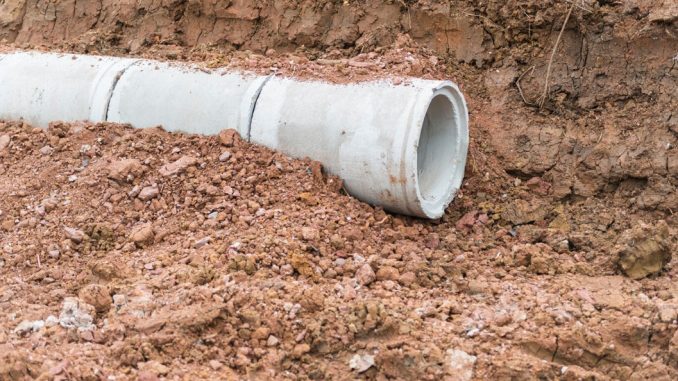
Most people will never be confronted with the prospect of making a repair to a cracked concrete pipe. Whereas copper and PVC run water through homes and businesses in the United Kingdom, concrete pipes tend to be buried underground as part of sewers and major infrastructure.
That can make fixing a concrete pipe seem like a daunting task capable of being carried out by only an expert. But guess what? It isn’t.
Concrete pipes may be bigger and therefore more susceptible to larger failures and areas of damage. But if you need to repair a concrete pipe, then you can deploy exactly the same method as with any other type of pipe material.
Sealing a crack in a concrete pipe
There are two ways for sealing a crack in a concrete pipe, depending on whether you can turn the pressure running through the pipe off or not.
If flow can be isolated, then an epoxy putty is used. For smaller cracks, a 114g Superfast Concrete Epoxy Putty Stick will quickly and easily fill the hole.
Epoxy putty is made up of two components, resin and hardener. When these are mixed together, a chemical reaction takes place which turns the soft material into one as hard as steel.
With a Superfast Stick, the resin and hardener are supplied pre-formatted. To use, you simply cut off the amount of putty required to fill the hole and knead it by hand.
Once the putty turns a uniform colour, then this indicates successful mixing. Whilst still soft, it is pushed into the crack in the pipe. It will then harden, permanently filling the hole to seal the leak with a repair pressure resistant up to 30 bar.
Superfast Concrete sets to a grey colour and the cured material shares a density and feel similar to concrete. It has a work time of 4 minutes and sets in 10 minutes, enabling fast repairs to be made to leaking concrete pipe.
The one downside of Superfast Concrete is its size. Bigger concrete pipes suffering from larger cracks and holes may require significant amounts of putty beyond what the 114g Stick offers.
Should this be the case, then it can be more effective to use an epoxy putty available in bulk quantities, like Sylmasta AB Original.
With AB Original, the resin and hardener come in separate tubs. Part A and Part B are mixed together in equal ratios.
Kilos can be mixed at once and the two-hour work time of the putty enables it to be carefully applied to fill the crack without the threat of premature curing.
Making a live leak repair to a concrete pipe
If pressure cannot be turned off, then epoxy putty may not bond effectively with the pipe surface when making a repair. Instead, a waterproof silicone pipe repair tape is needed.
A product like Wrap & Seal Pipe Burst Tape stretches by up to 300 percent when wrapped around pipes. This enables the self-amalgamating silicone to fuse to itself, forming a solid rubber band over a crack or hole capable of sealing live leaks.
The application starts with the tape anchored slightly to the side of the leak. As it is wrapped, the tape moves towards the hole or crack before being applied directly over the top, so that layers form a ridge over the hole.
Multiple tapes can be applied on top of each other. Further fusion takes place between the separate tapes, increasing pressure resistance until no more water is able to escape from the pipe.
The pipe size and the required pressure resistant will determine how many tapes are needed and how long it takes to seal the pipe. Generally, Wrap & Seal can be applied in less than 15 minutes.
Reinforcing a concrete pipe repair to create a permanent solution
Once the hole in the concrete pipe has been successfully sealed, the line should be reinforced with a composite repair wrap such as SylWrap HD Pipe Repair Bandage.
SylWrap HD contains a water-activated resin. The bandage is wetted and then wrapped and smoothed around the pipe, where it will quickly cure to form a rock-hard, impact resistant protective shell.
The reinforcement stage is particularly important when dealing with pipes which are underground. Lines which are reburied after repair require added protection, especially when Wrap & Seal has been used.
Stones and other sharp objects can prick the tape, causing pressure resistant to drop and leaks to potentially reappear.
Pipes which have been reinforced and protected with a composite sleeve are permanently repaired and able to withstand the pressure of going back underground.
Concrete pipe repair in industry
Concrete pipe repair continues to be a hot topic in industry, most notably in areas where prestressed concrete cylinder pipe (PCCP) is found.
Once considered one of the strongest and most durable pipe types around, the composition of PCCP was changed during the 1970s in an attempt to make production costs cheaper.
This proved to be a catastrophic mistake. Pipes fabricated during that era were produced severely below specification and within 30 years, blowouts were frequently occurring.
Prestressed concrete cylinder pipes can be up to 3.5 metres in diameter and carry huge amounts of water at high pressures, meaning that when explosions occur in PCCP lines they can be devastating.
With prevention being better than a cure, thousands of kilometres of PCCP lines in the United States are undergoing reinforcement at a cost of billions of dollars.
The same method and materials used for smaller, domestic concrete pipe applications can be transferred for PCCP repair. It simply require a lot more putty, a lot more tape and a lot more bandage.

Leave a Reply